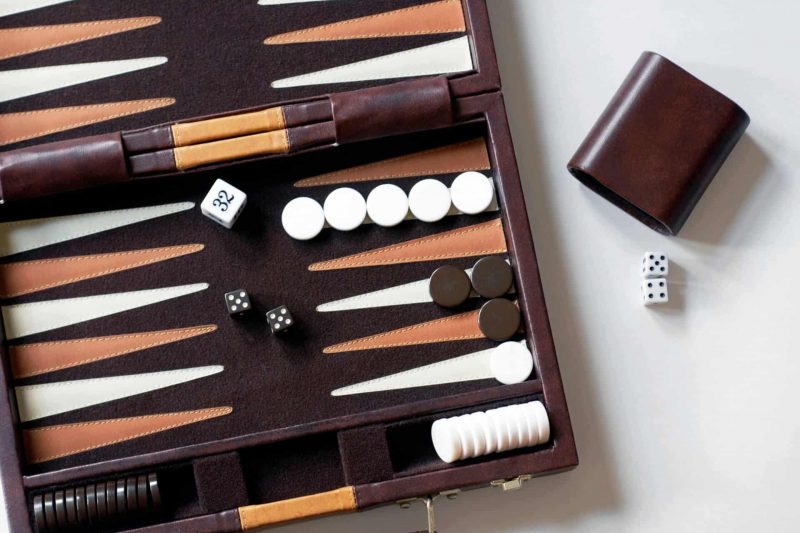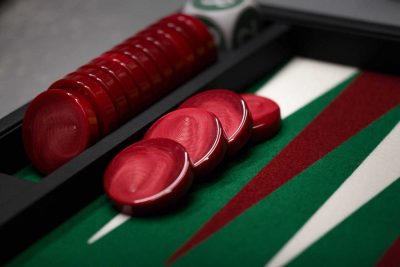Backgammon is an enduringly popular board game, and for good reasons. It’s easy to learn, exciting to play, fascinating to study. It’s ultimately a game of skill. However, the element of luck provides drama, and the dice act to level the playing field so that novices can enjoy a chance to win even against a seasoned veteran. This page provides some practical pointers for players just starting out on their backgammon journey.
Equipment You’ll Need
Pictured here is a complete backgammon set ready for action. The essential elements are a playing field, two sets of 15 checkers, one or two pairs of dice, and a doubling cube. Optional elements are dice cups, extra cubes for chouette play, a scoreboard for match play, and a clock for timed matches.
Anatomy of a Backgammon Board
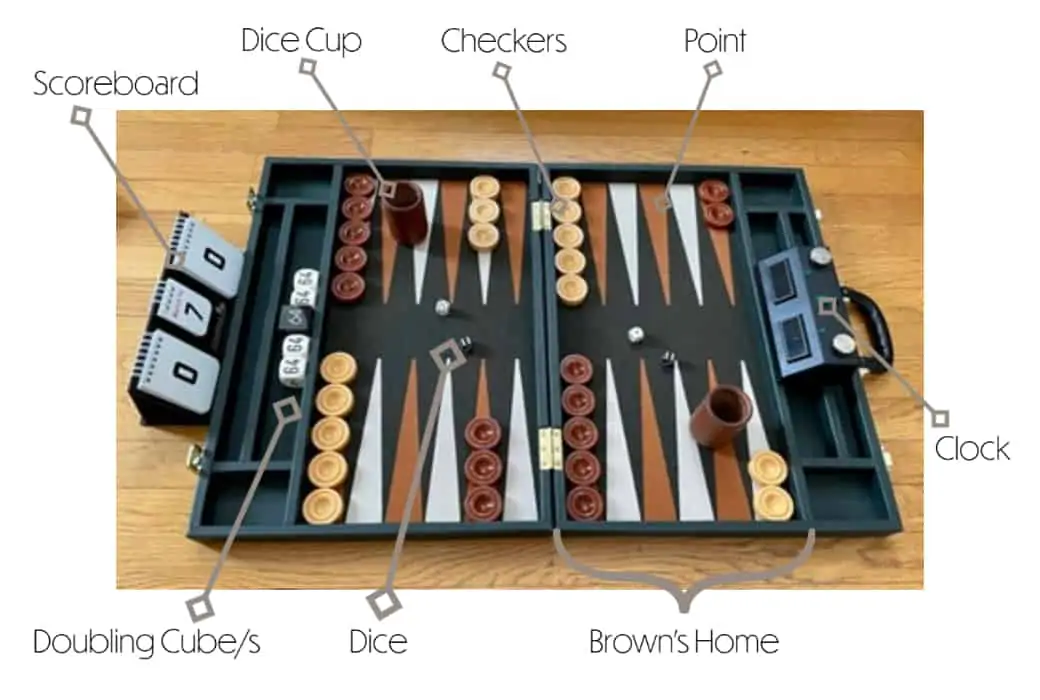
Somewhere in your game closet, there may be an old checkerboard with a backgammon board on the flip-side. If it still has 30 checkers and a pair of dice, you’re in business. But there may even be a nice attaché style set left over from the 1970s boom when backgammon sets were about as ubiquitous as Fleetwood Mac’s Rumours album.
Of course, these days, you don’t even need a physical set as you can hop online and play with people all over the world in a few minutes. For more on that option, see Venture Online for Fresh Competition, farther down on this page.
But if you need to purchase a backgammon board, you’ll find plenty of inexpensive sets via a simple internet search. Or, if you want to spring for a more luxurious set, you can explore high-end offerings listed on the New England Backgammon Club website.
A great resource to purchase quality boards, even used boards in good condition, is Carol Joy Cole’s Backgammon Boutique.
Basic Rules
The rules of the game — which involve racing checkers around the board according to dice rolls while knocking your opponent’s checkers back and blocking their checkers behind walls of your own pieces — can be found on our How to Play page. Or you can watch a terrific quick course on rules and basic strategy in this Backgammon Galaxy video tutorial.
4 Standard Ways to Play Backgammon
1. Single Games, without the Doubling Cube
The simplest and oldest approach to competing at backgammon is one game at a time, in a session that ends upon mutual agreement. This mode is often referred to in backgammon lingo as unlimited. This is in contrast with match play, where the contest ends with a pre-defined number of points.
In an open-ended session, each game is as important as the next. You can keep a running tally of points: 1 point for a typical win, 2 points for a gammon, and 3 points for a backgammon.
Depending on your habits, you can start a fresh new series every night, every week, or every month. Perhaps attach a prize to the player who comes out ahead — movie choices! Or a penalty to the loser — garbage duty!
2. Single Games, with the Doubling Cube
Once you are very familiar with the rules and have a good sense of how games tend to play out, try adding a whole new dimension of excitement by implementing the doubling cube. The concept of doubling revitalized the game when it was introduced in the mid-1920s. Various methods for keeping track of doubles were used until the doubling cube came into common use. It is now an essential element in competitive play both in the U.S. and internationally.
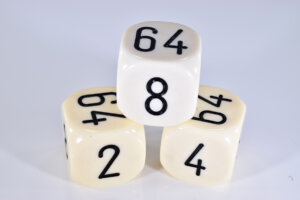
Doubling enables a single game to be worth a much broader — and, technically, unlimited — number of points, making for a thrilling dynamic contest. After playing with the cube, playing without it will seem plodding. Instead of a game being limited to 1, 2, or 3 points each, the cube multiplies that value. And, the cube can be redoubled an unlimited number of times in a single game. A game that, without the cube, would have been worth just 1 point can now be worth 2, 4, or 8 points, with the occasional 16 or even 32-point coups.
But it isn’t just the greater point values that make doubling play so thrilling — it’s the deeper thought and insight that cube decisions demand of us and the emotional intensity that can come with venturing to double the stakes or to accept a double in a volatile position. Without the cube, you just roll the dice and do what you can. Cube play requires you to think about the overall state of the game, gauge the degree of your advantage or disadvantage, and envision how the game is likely to play out. Cube strategy is generally seen as equal to checker play in determining your success in competitive backgammon.
3. Match Play
In match play, the goal is to win a predetermined number of points. By tradition, matches are played to an odd number of points, typically 5, 7, or 9. The first player to reach that benchmark wins the match. The doubling cube is in play, making it possible for every game to end the match.
This mode adds drama to the contest, particularly when one player takes a large lead, say going up 7–2 in a match to 9 points. When playing single, aka unlimited games, one can have all day to recover from a deficit or perhaps win it back in one big game. But when you are trailing in match play, the pressure is on to get winning now. Score differences can significantly affect cube strategy since the trailing wants games to be worth a lot. At the same time, the leader will be very wary of offering a cube that could be instantly re-doubled and give their opponent a chance to leap back into contention.
There are some particular rules governing cube action regarding the score in tournament play, which you can find in video 15 covering the Crawford rule.
Match play has a distinct character, turning a rambling session into a focused contest or series of contests. It is also the standard for online backgammon sites and for backgammon tournaments.
Since luck is so large a factor in backgammon, longer match lengths favor the stronger player, as skill has a better chance of winning out in a long series of games. In tournaments, match lengths are sometimes increased in the final rounds to provide a more meaningful contest.
4, Multi-Player Games – Called Chouettes
Along with the doubling cube, jazz-era players came up with a multi-handed approach to backgammon that has made the game a more social pastime by allowing groups to play. In a chouette, a single player, called the Box, plays alone against a Captain who plays on behalf of the rest of the players, called the Crew. Depending on local rules, which can vary, Crew members may be allowed to advise the Captain on how to play the checkers at various points in the game, in an effort to knock the lone player out of the Box.
When the game ends, the winning player becomes, or remains, the Box. The losing player goes to the end of the Crew line and waits for their turn to become Captain, and the next Crew member becomes the new Captain. The Box remains the Box so long as they keep winning, while a fresh Captain is seated every game.
In the modern version of a chouette, each player plays with a separate cube and may double and take independently from the Crewmates — though rules for cube action also vary from town to town. A running score is kept for each player, taking care that each line on the score sheet balances out to zero.
Backgammon for Kids and Teens
Backgammon can provide endless hours of fun for the whole family. Even very young ones can enjoy simple made-up counting games using the checkers and dice that will prepare them for deeper interest later on. For instance, try just setting up all the checkers equally in the home boards and simply play the bear-off phase! A great way to introduce the basic concept of backgammon and to get comfortable seeing how the dice rolls correspond to points on the board is the stripped-down variant known as hypergammon. Each player begins with just three checkers — one each on the 24, 23, and 22 points — and the game is played as usual.
Hypergammon Starting Position
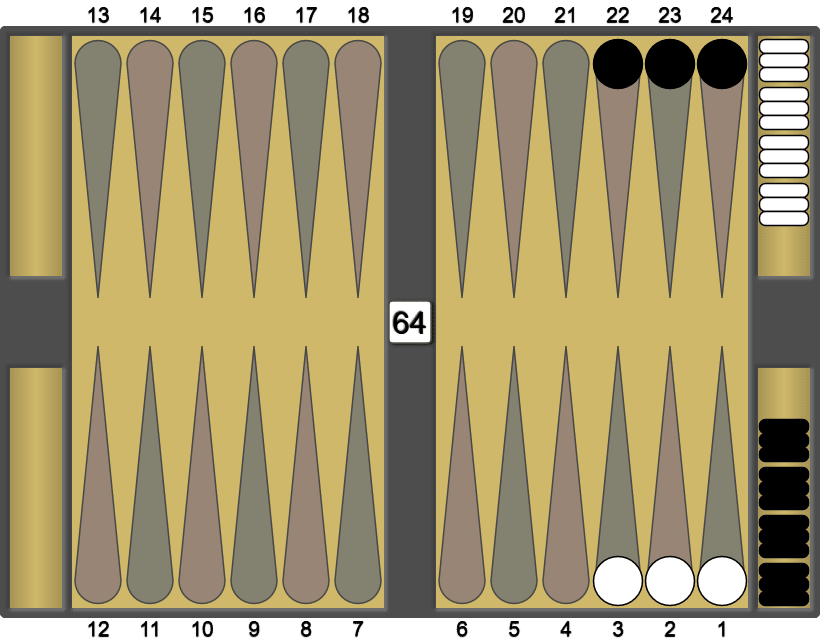
Backgammon is a superb game for learning essential life skills such as risk-reward decision-making and cost vs. benefit analysis. Very few good backgammon players are suckered into over-priced extended warranty offers. Backgammon also provides an opportunity to teach emotional self-control. As unexpected setbacks and bad turns of luck must be endured and accepted without allowing them to cloud your judgment. Backgammon demands a certain grace under pressure and, of course, good sportsmanship in defeat. And if responsible risk-taking is one of the keys to human happiness, backgammon provides plenty of practice.
Backgammon can make learning math fun! Younger children can learn to add numbers by using dice. Teens can explore how a limited set of numbers can create many possibilities of combinations. With two dice, we have 36 possible number combinations. It is eminently helpful to understand the likelihood of rolling specific numbers or which play gives your opponent the fewest chances to hit you.
Higher levels of backgammon play require a good understanding of mathematical probability theory. Introducing your child to these concepts can be fun and rewarding, but make sure to keep the emphasis on fun. Let your child take the lead, they will let you know when they are ready to learn more.
This resource introduces backgammon dice statistics, moves, and odds for kids.
Venture Online for Fresh Competition
When you’re the strongest player in your field, it’s very easy to imagine you’ve learned all there is to know about backgammon and that you’re “good at it.” Diving into a much larger pool of avid players is likely to be a humbling experience, but it will also be a broadening one that can spur you on toward serious study of the game. And as with watching baseball or listening to opera, backgammon gets more interesting the more you learn about it.
Currently, the most popular free online backgammon site is backgammongalaxy.com. It’s easy to register, and the site has an appealingly simple playing interface. When you visit the Play tab, you will see a slate of matches to join, and you can easily create a game of your own desired length and clock settings. The unique aspect of this site is a rating system that demands not only that you win but also that you play more accurately than your opponent — as decided by a powerful analysis program. After your match concludes, you are provided with an analysis of each move and decision. This is valuable because reviewing your own errors can help rapidly improve your game. The site is still relatively young and is working on improving the experience. Still, it’s well worth trying out, and you may find playing there addictive.
Another option that’s particularly useful if you would like to play with known friends online, is backgammonhub.com, which doesn’t even require a permanent registration! Just agree on a time to meet, type in a provisional player name, and off you go. However, this site works on some web browsers and not on others: your best chances seem to be visiting it on the Chrome platform.
Backgammon Studio Heroes is another site that provides free in-game analysis. It has an overwhelming number of options and settings, so it can take some time to learn the interface. Still, many players appreciate the comfortable playing experience. Sign up for an account at backgammonstudio.com.
Become a Student of the Game
Once you have played enough backgammon to care about playing it well, there are plenty of ways to go about improving.
Books & Magazines
Modern players have plenty of excellent instructional materials available. Some address the various game strategies very broadly, and others delve into more specific aspects of the game. The USBGF member magazine PrimeTime Backgammon regularly features highly instructive articles, as well as complete match analyses with in-depth commentary. PrimeTime Backgammon comes with a USBGF Premium membership.
Online Resources
Our education section contains a treasure trove of videos, articles, and quizzes to help you improve your game.
In the Internet age, backgammon writing has moved out of newspapers, magazines, and newsletters and now flourishes on some online sites, notably GammonVillage Magazine, a subscription service that offers a deep archive of columns by an all-star cast of top backgammon theorists and teachers.
Further resources of this kind are available at the New England Backgammon Club website.
Backgammon Analysis Software
Modern backgammon has been transformed by the advent of highly successful software programs, which have become the popular measuring stick for evaluating the quality of human play. Currently, the very affordable eXtreme Gammon is the gold standard for backgammon evaluation. It is an indispensable tool for those looking to compete at the highest levels. USBGF premium members qualify for a discount.
Backgammon Lessons
Your chances of finding a local backgammon expert to provide you with lessons are probably very small unless you happen to live in certain towns. There are a growing number of accomplished players offering lessons remotely via video conferencing or by phone. The Backgammon Learning Center is the easiest way to find such a mentor.
Enormous thanks to Albert Steg, director of the New England Backgammon Club, for generously providing source material for this article.


